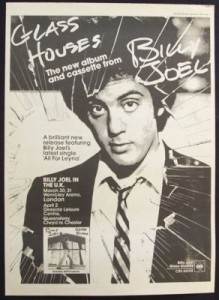I’ve made it through six albums in my ongoing Billy Joel retrospective, which means it’s time to write a review for his seventh: Glass Houses. It’s certainly one of Joel’s best albums, and I’ve been listening to it again recently in preparation for writing the review.
There’s one thing I noticed that I wanted to comment on but that would be too big of a tangent to include in the review.
Glass Houses is not that far from a concept album of the rise and fall of a romance between Joel and a broken, guarded woman. Cut a couple of songs, rearrange the track listing, and you almost have a continuous story.
The reinvention does not work 100% perfectly. Joel uses two different female names (Diane and Leyna) and a couple of the tracks make contradictory observations about their subjects. Still, it’s an interesting exercise and works surprisingly well.
Here’s how I see it:
- Two tracks are left on the cutting board, as they do not deal with relationships or women: “It’s Still Rock and Roll to Me” and “Close to the Borderline.” This leaves the new arrangement at eight tracks (which is the same number as on Turnstiles, dispelling concerns that the reinvention would be unreasonably short).
And here’s the track listing:
- Sleeping with the Television On – Billy Joel meets and observes a guarded woman who refuses to open up to him.
- Don’t Ask Me Why – He begins to decode this woman. He figures out that she is haunted by her past.
- You May Be Right – She continues to resist his advances. In fact, she thinks he’s crazy for wanting to be with her so badly. He tries to convince her otherwise.
- I Don’t Want to Be Alone – She finally gives Billy a chance. She’s lonely and relents to his interest in her.
- Through the Long Night – The two are together. Joel comforts her as she opens up to him and faces her demons.
- All For Leyna – The woman’s intense personality causes Joel to become both obsessed with and troubled by their relationship.
- C’etait Toi (You Were the One) – The relationship falls apart. Joel confronts his loneliness and comes to grip with just how much of an impact she had on him.
- Sometimes a Fantasy – Joel resorts to shallow indulgences (in this case, a sex hotline) as he faces the world alone again.
What I love about this is that it comes full circle. It’s a cycle. The first song picks up right where the last one ends: Joel lonely and looking for company.
I think looking at Glass Houses this way also enhances the impact of some of the album tracks. On their own, tracks like C’etait Toi and Through the Long Night work well, but as part of an emotional arc I find them a lot more moving.
So, what do you think? Am I on to something, or am I crazy? Maybe over-thinking it just a little? Either way, someone should come up with a catchy title and some remixed album art for this.






Pingback: You May Be Right / ガラスのニューヨーク(Billy Joel / ビリー・ジョエル)1980 | 最新音楽情報まとめサイト